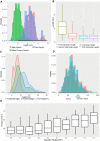Analysis of Shoot Architecture Traits in Edamame Reveals Potential Strategies to Improve Harvest Efficiency
- PMID: 33746998
- PMCID: PMC7965963
- DOI: 10.3389/fpls.2021.614926
Analysis of Shoot Architecture Traits in Edamame Reveals Potential Strategies to Improve Harvest Efficiency
Abstract
Edamame is a type of green, vegetable soybean and improving shoot architecture traits for edamame is important for breeding of high-yield varieties by decreasing potential loss due to harvesting. In this study, we use digital imaging technology and computer vision algorithms to characterize major traits of shoot architecture for edamame. Using a population of edamame PIs, we seek to identify underlying genetic control of different shoot architecture traits. We found significant variations in the shoot architecture of the edamame lines including long-skinny and candle stick-like structures. To quantify the similarity and differences of branching patterns between these edamame varieties, we applied a topological measurement called persistent homology. Persistent homology uses algebraic geometry algorithms to measure the structural similarities between complex shapes. We found intriguing relationships between the topological features of branching networks and pod numbers in our plant population, suggesting combination of multiple topological features contribute to the overall pod numbers on a plant. We also identified potential candidate genes including a lateral organ boundary gene family protein and a MADS-box gene that are associated with the pod numbers. This research provides insight into the genetic regulation of shoot architecture traits and can be used to further develop edamame varieties that are better adapted to mechanical harvesting.
Keywords: breeding; edamame; persistent homology; phenotyping; shoot architecture.
Copyright © 2021 Dhakal, Zhu, Zhang, Li and Li.
Conflict of interest statement
The authors declare that the research was conducted in the absence of any commercial or financial relationships that could be construed as a potential conflict of interest.
Figures




Similar articles
-
The effects of Meloidogyne incognita and Heterodera glycines on the yield and quality of edamame (Glycine max l.) in Arkansas.J Nematol. 2020;52:1-15. doi: 10.21307/jofnem-2020-012. J Nematol. 2020. PMID: 32180382 Free PMC article.
-
Effect of Planting Date and Cultivar Maturity in Edamame Quality and Harvest Window.Front Plant Sci. 2021 Jan 18;11:585856. doi: 10.3389/fpls.2020.585856. eCollection 2020. Front Plant Sci. 2021. PMID: 33537038 Free PMC article.
-
Molecular Regulation of Shoot Architecture in Soybean.Plant Cell Environ. 2024 Sep 10. doi: 10.1111/pce.15138. Online ahead of print. Plant Cell Environ. 2024. PMID: 39254042
-
Genetic Regulation of Shoot Architecture.Annu Rev Plant Biol. 2018 Apr 29;69:437-468. doi: 10.1146/annurev-arplant-042817-040422. Epub 2018 Mar 19. Annu Rev Plant Biol. 2018. PMID: 29553800 Review.
-
Shaping plant architecture.Front Plant Sci. 2015 Apr 9;6:233. doi: 10.3389/fpls.2015.00233. eCollection 2015. Front Plant Sci. 2015. PMID: 25914710 Free PMC article. Review.
Cited by
-
Effects of Climate Conditions before Harvest Date on Edamame Metabolome.Plants (Basel). 2023 Dec 27;13(1):87. doi: 10.3390/plants13010087. Plants (Basel). 2023. PMID: 38202395 Free PMC article.
-
Comparative transcriptome analysis of vegetable soybean grain discloses genes essential for grain quality.BMC Plant Biol. 2024 Jun 3;24(1):491. doi: 10.1186/s12870-024-05214-1. BMC Plant Biol. 2024. PMID: 38825702 Free PMC article.
-
Mapping and quantifying unique branching structures in lentil (Lens culinaris Medik.).Plant Methods. 2024 Jun 19;20(1):95. doi: 10.1186/s13007-024-01223-1. Plant Methods. 2024. PMID: 38898527 Free PMC article.
-
Multi-Omics Analysis Provides Insights into Green Soybean in Response to Cold Stress.Metabolites. 2024 Dec 7;14(12):687. doi: 10.3390/metabo14120687. Metabolites. 2024. PMID: 39728468 Free PMC article.
-
Genome-wide association analysis of sucrose and alanine contents in edamame beans.Front Plant Sci. 2023 Feb 3;13:1086007. doi: 10.3389/fpls.2022.1086007. eCollection 2022. Front Plant Sci. 2023. PMID: 36816489 Free PMC article.
References
-
- Adams J., Qiu Y., Xu Y., Schnable J. C. (2020). Plant segmentation by supervised machine learning methods. Plant Phenome J. 3:e20001. 10.1002/ppj2.20001 - DOI
-
- Barth R., IJsselmuiden J., Hemming J., Van Henten E. J. (2019). Synthetic bootstrapping of convolutional neural networks for semantic plant part segmentation. Comput. Electron. Agric. 161 291–304. 10.1016/j.compag.2017.11.040 - DOI
-
- Bates D., Machler M., Bolker B., Walker S. (2014). Fitting linear mixed-effects models using lme4. J. Stat. Softw. 67 1–48. 10.18637/jss.v067.i01 - DOI
LinkOut - more resources
Full Text Sources
Other Literature Sources

